Cities require extensive integrated public transport networks that solve complete trips (door to door) in an attractive way. The feeder buses, bikes and walking solve “the last mile”, while the trunk lines solve the long section quickly thanks to their exclusive lane.
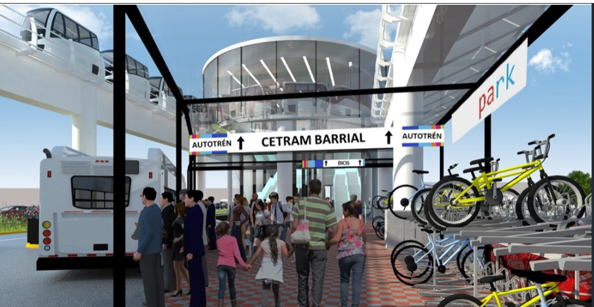

Autotren trunk lines can be at-grade, underground or elevated, depending on what is most convenient.
At level: In roads with a vocation for fast lane and high flow of mixed traffic, where there has been investment in overpasses, elimination of traffic lights, the pedestrian crossing is by means of bridges, and there is space in the center. There, the Autotrén is an investment cost alternative very similar to a BRT, but with the benefits of an electric train, higher speed and a guaranteed seat.
Subway: In historic centers where architecture is to be preserved and larger spaces mainly for pedestrians generated, the Autotrén allows for the most economical underground solution with two alternatives: 1) Cut-and-cover tunnel at surface level, which is cheaper but can be slower due to presence of archaeological objects and by the induced work of underground services, and 2) Pair of twin micro-tunnels at greater depths built with micro-tunnels, whose cost is higher than that of the cut-and-cover tunnel, but still a fraction of that of tunnels for conventional trains whose diameter is significantly larger
Elevated: When, in order to achieve a greater benefit to the entire population, the aim is not to eliminate lanes but to add totally additional infrastructure through an elevated viaduct in those roads whose vocation and section allow it.
The average speed is 38-45 km/h. This is faster than the rush hour car and twice as fast as BRT (confined bus systems). The capacity is 19,200 passengers/hour-direction per lane.
How is it achieved? Below is the capacity of each element of the system:

Characteristic
Only seated passengers
Door 500 thousand cycles guaranteed
Folding central seats for wheelchair or luggage
Capacity: 8 passengers per car
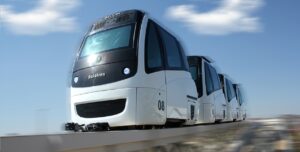
Characteristic
Trains with 1, 2, 3 or 4 cars mechanically coupled
Automated docking/undocking at stations
Ability
8 passengers/car * 4 cars/train = 32 passengers per train
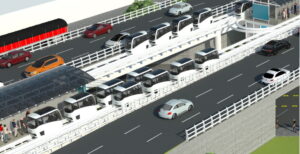
Characteristic
The fleet is optimized because the pairs of stations with the highest demand are served with express routes, the medium ones with semi-express routes and the rest with a stop-on-demand route.
Ability
The fleet is sized for the busiest section, but thanks to overtaking, returns and express routes, the train offer is adapted to the different sections along the corridor.
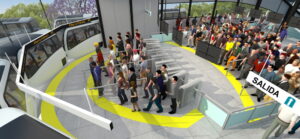
Characteristic
smart grouping
Management of available seats
Cycle time between trains on the platform of 48 seconds
Ability
3,600 sec/hour ÷ 48 sec = 75 trains/hour per platform * 32 passengers/train = 2,400 passengers/per platform
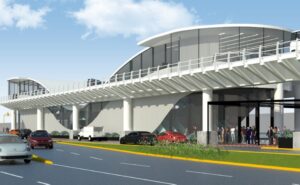
Characteristic
Physical integration with feeder buses, public bikes and mass bike parking
The stations are formed with as many platforms in parallel as required
Ability
For example, a station with two platforms (as in the image):
2 platforms * 2,400/ pax per platform = 4,800 passengers per double platform station
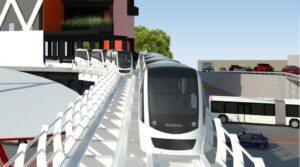
Characteristic
The functional safety level of the CBTC system determines the minimum separation between trains, which is 6 seconds.
Ability
3,600 sec/hour ÷ 6 sec = 600 trains/hour per lane * 32 passengers/train = 19,200 passengers/hour per lane
In the world’s great megalopolises, there are public transport corridors that at peak times have more than 20,000 passengers per hour per direction (pphpd), including up to 40,000 pphpd. These corridors can only be solved by heavy Metros or tri-articulated BRT with passing.
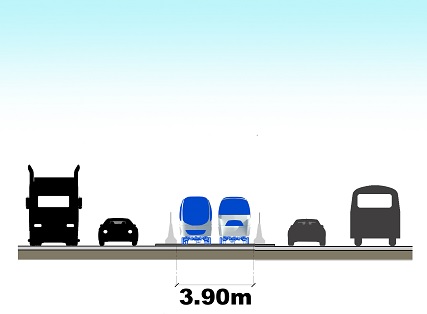
In roads with high flow and high speed of mixed traffic (highway type), the Autotrain at level is an infrastructure solution as economical as making bus lanes, but to generate electric train benefits.
The cost of the infrastructure at the Autotren level ranges from 20-30 million pesos, similar to the cost of building exclusive lanes for bus rapid transit (“BRT”) systems.
But the average speed of the Autotrén (40km/h) is double the speed of a BRT system (20km/h), in addition to offering a guaranteed seat, for greater comfort and safety.
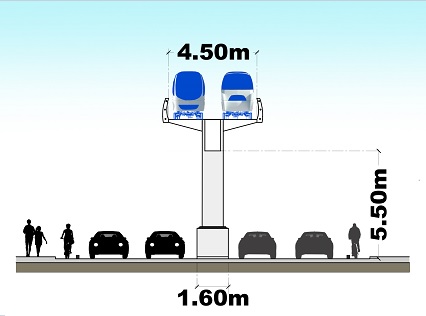
In urban contexts where there is no space at street level, the Autotrén viaduct is the cheapest solution to provide exclusive road infrastructure to enable fast public transport without affecting lanes.
Frees up space at street level for pedestrians and cyclists without removing lanes from mixed traffic.
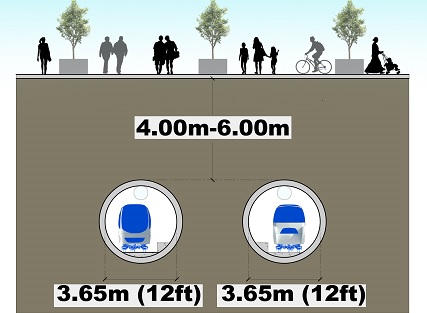
The city centers are the great attractors of travel, Autotrén makes possible a Metro-type solution with economical micro-tunnels at a depth that avoids induced works and an area of historical vestiges.
While the tracks are micro-tunnels at a depth to free underground installations and areas of historical remains, the stations are cut-and-cover tunnels (similar to building a depressed passage for mixed traffic), to achieve an economical underground solution in a comprehensive manner, both in tracks and in stations.
In the world’s great megalopolises, there are public transport corridors that at peak times have more than 20,000 passengers per hour per direction (pphpd), including up to 40,000 pphpd. These corridors can only be solved by heavy Metros or tri-articulated BRT with passing.
In those cases, the Autotrén is:
What if the overload is only in one section?
In the right of way of a conventional train, there is room for 4 Autotren lanes, so it is possible to have double tracks to achieve capacities greater than 20,000 pphpd with Autotren in the sections that require it. For example, at the confluence of two or more Autotren feeder lines of a Metro terminal.
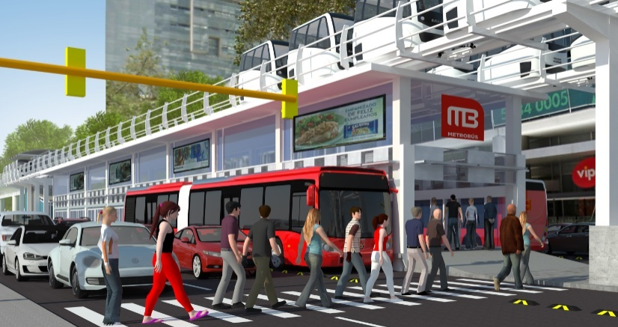

A connection to the airport is key to increasing the competitiveness of our cities. This is achieved with a strong, electrical, fast, comfortable and above all reliable connection.
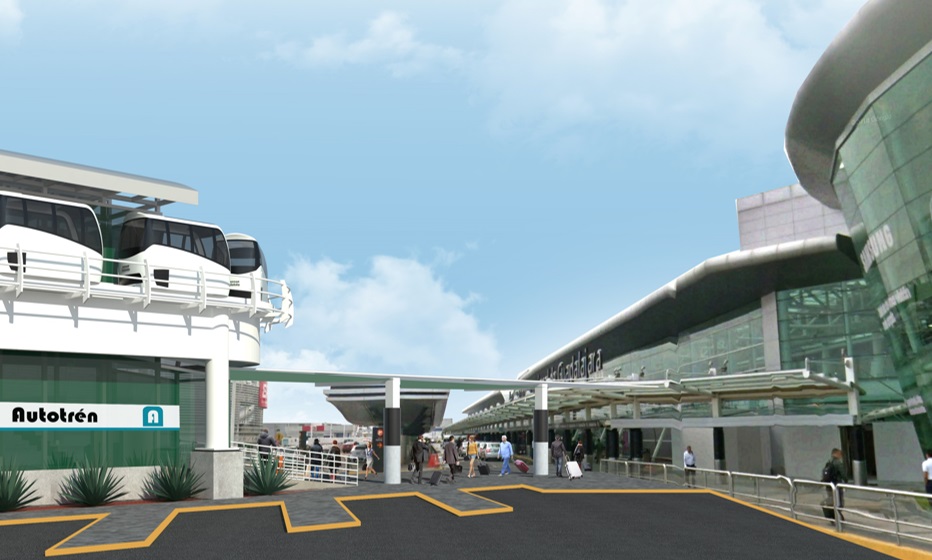
With Autotrén you can establish a differentiated service and rates between public transport users and air passenger users.
The passing lanes, the possibility of operating different types of vehicles and the operation on demand allow for 100% express services to the Airport, with vehicles with luggage racks and passenger stations located right in front of the terminal buildings for a higher rate.
In combination with normal services to stations still within the airport complex for a normal public transport fee.
The reliability of having a railway connection independent of traffic increases the attractiveness of our cities as trade fair and tourist destinations and as regional hubs.
Several cities have disused freight railroad tracks that could be used for passenger transportation.
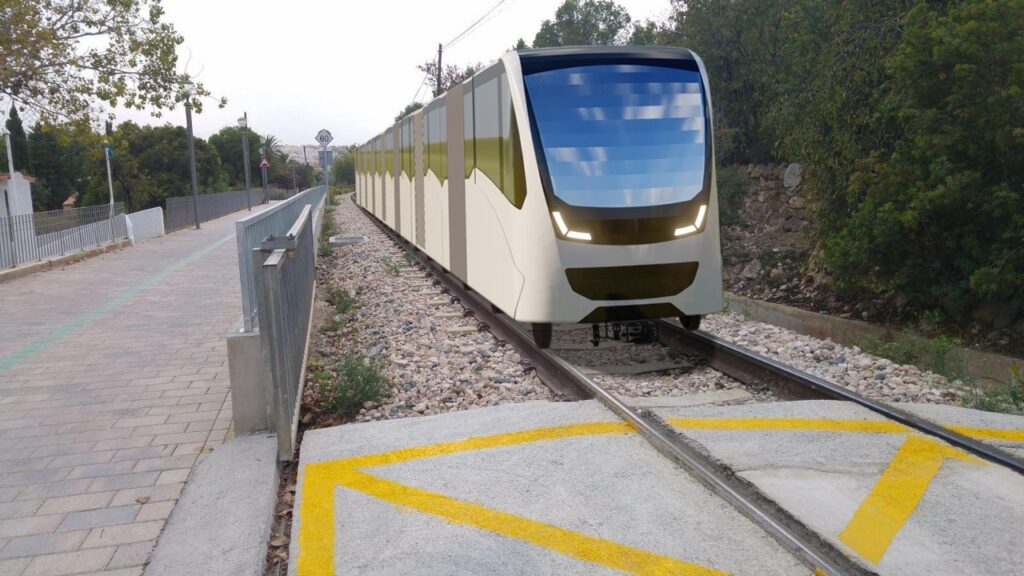
Autotren can be adapted to operate on railway tracks.